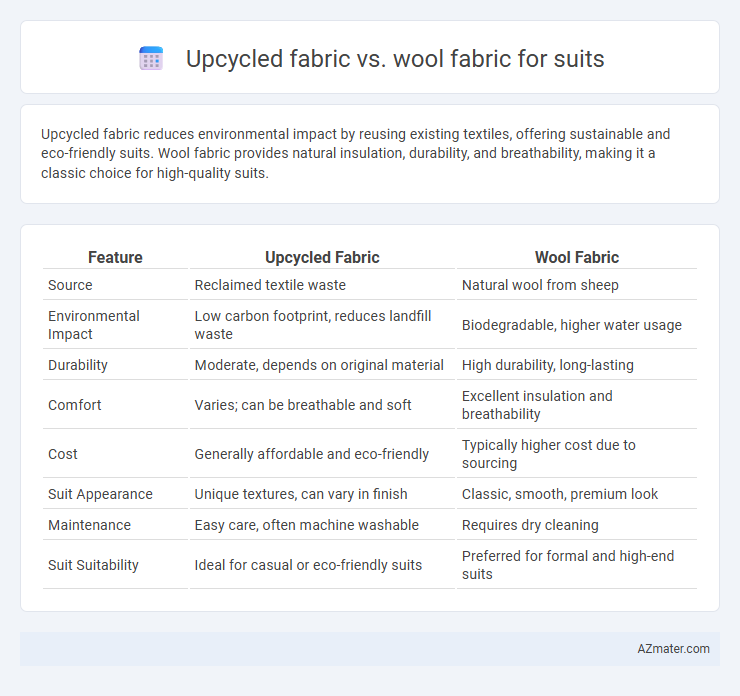Upcycled fabric reduces environmental impact by reusing existing textiles, offering sustainable and eco-friendly suits. Wool fabric provides natural insulation, durability, and breathability, making it a classic choice for high-quality suits.
Table of Comparison
| Feature | Upcycled Fabric | Wool Fabric |
|---|---|---|
| Source | Reclaimed textile waste | Natural wool from sheep |
| Environmental Impact | Low carbon footprint, reduces landfill waste | Biodegradable, higher water usage |
| Durability | Moderate, depends on original material | High durability, long-lasting |
| Comfort | Varies; can be breathable and soft | Excellent insulation and breathability |
| Cost | Generally affordable and eco-friendly | Typically higher cost due to sourcing |
| Suit Appearance | Unique textures, can vary in finish | Classic, smooth, premium look |
| Maintenance | Easy care, often machine washable | Requires dry cleaning |
| Suit Suitability | Ideal for casual or eco-friendly suits | Preferred for formal and high-end suits |
Introduction: Upcycled Fabric vs Wool Fabric for Suits
Upcycled fabric for suits presents an eco-friendly alternative by repurposing existing textiles, reducing waste and environmental impact compared to traditional wool fabric. Wool fabric, known for its durability, breathability, and natural insulation, remains a classic choice for high-quality suits. Choosing between upcycled and wool fabric depends on priorities such as sustainability, texture preferences, and climate suitability.
Sustainability and Environmental Impact
Upcycled fabric for suits reduces textile waste by repurposing discarded materials, significantly lowering the demand for new resources and minimizing landfill contributions. Wool fabric, while biodegradable and renewable, requires substantial water, land, and energy usage during production, contributing to environmental degradation. Choosing upcycled fabric over traditional wool suits supports circular fashion by decreasing carbon footprint and conserving natural resources.
Sourcing and Production Processes
Upcycled fabric for suits is sourced from recycled textile waste, reducing environmental impact by diverting materials from landfills and minimizing the need for virgin resources. Wool fabric is obtained from sheep shearing, requiring extensive animal husbandry, water, and land use, with production involving processes like carding, spinning, and weaving. Upcycled fabric production emphasizes sustainability and waste reduction, while wool fabric production centers on natural fiber harvesting and traditional textile techniques.
Material Characteristics and Texture
Upcycled fabric for suits combines sustainability with unique texture variations due to reclaimed fibers, offering an eco-friendly alternative with a slightly irregular surface compared to traditional materials. Wool fabric, known for its natural breathability, elasticity, and insulating properties, provides a smooth, refined texture ideal for formal tailoring. The inherent resilience and moisture-wicking ability of wool ensure durability and comfort, while upcycled fabrics emphasize environmental impact without compromising style.
Comfort and Breathability
Upcycled fabric suits offer enhanced breathability due to the use of lightweight, repurposed fibers that allow better air circulation and moisture-wicking properties, ensuring comfort during extended wear. Wool fabric suits provide superior temperature regulation and natural insulation, adapting well to both warm and cool climates, while maintaining softness that enhances comfort. Both materials deliver distinct advantages in comfort and breathability, with upcycled fabrics emphasizing eco-friendly lightweight feel and wool prioritizing natural temperature control.
Durability and Longevity
Upcycled fabric suits offer moderate durability, benefiting from recycled fibers but often lacking the consistent strength of wool, which is known for its natural resilience and long lifespan. Wool fabric suits provide superior longevity due to wool's inherent elasticity, resistance to wrinkles, and ability to retain shape over time, making them a preferred choice for long-term use. While upcycled fabrics contribute to sustainability, wool suits remain unmatched in durability and a refined appearance for extended wear.
Style Versatility and Appearance
Upcycled fabric suits offer unique patterns and textures, creating a distinct, eco-friendly style that stands out in modern wardrobes. Wool fabric suits provide classic elegance with a smooth finish, known for their timeless appeal and superior drape. Both materials enhance appearance through versatile tailoring options, but wool maintains a refined, polished look ideal for formal settings.
Cost and Accessibility
Upcycled fabric suits typically offer a more affordable option compared to traditional wool suits, as they utilize recycled materials that reduce production costs. Wool fabric suits often come with a higher price tag due to the quality of raw wool fibers and the craftsmanship required. Accessibility for upcycled fabrics is increasing through sustainable fashion brands, while wool suits remain widely available in most formalwear outlets and tailor shops.
Suitability for Different Occasions
Upcycled fabric suits offer a unique, eco-friendly aesthetic ideal for casual and creative environments, reflecting sustainability and individuality. Wool fabric suits provide excellent versatility, maintaining breathability and wrinkle resistance suitable for formal business settings, weddings, and colder climates. Choosing between upcycled and wool fabrics depends on the occasion's formality, desired comfort, and environmental considerations.
Choosing the Right Fabric for Your Suit
Upcycled fabric suits offer an eco-friendly and unique style by reusing existing textiles, making them ideal for sustainability-conscious consumers. Wool fabric suits provide superior breathability, durability, and natural wrinkle resistance, ensuring long-lasting comfort and a classic look. When choosing the right fabric for your suit, consider factors like environmental impact, fabric performance, and intended use to balance style with functionality.

Infographic: Upcycled fabric vs Wool fabric for Suit
 azmater.com
azmater.com